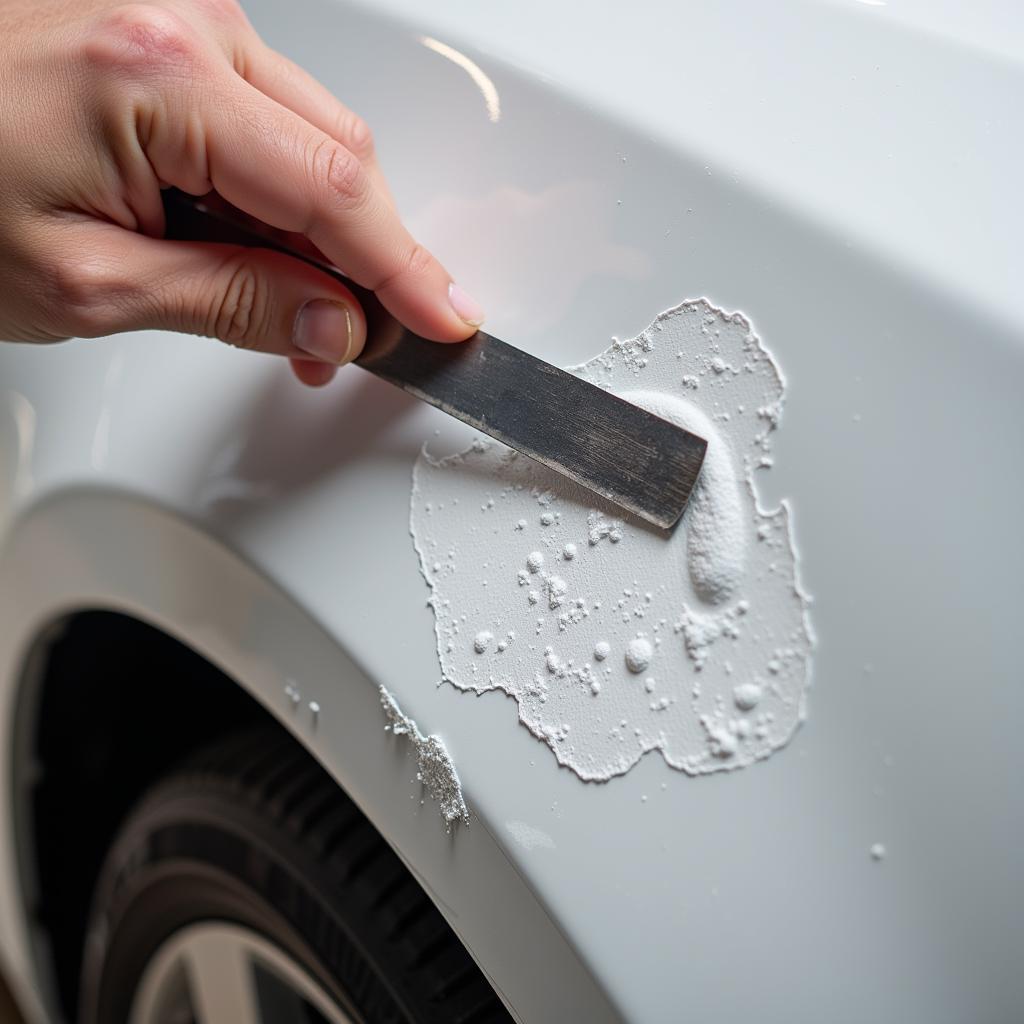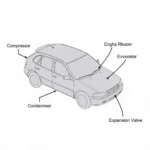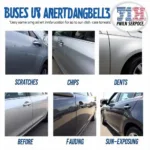Car paint bubbles, often a sign of underlying issues, can detract from your car’s appearance and potentially lead to more serious problems if left untreated. This comprehensive guide will walk you through how to repair car paint bubbles effectively, saving you money and restoring your car’s finish. Learn the causes, prevention, and step-by-step repair process for achieving professional-looking results.
Understanding the Causes of Car Paint Bubbles
Before diving into the repair process, it’s crucial to understand why car paint bubbles form. This knowledge helps prevent future occurrences. Common culprits include moisture trapped beneath the paint, improper paint application, and rust formation. Environmental factors like sun exposure and harsh weather conditions can also contribute to the problem. If the bubbles are accompanied by a rusty hue, it indicates rust underneath the paint, requiring more extensive repair work. This involves removing the rust completely before repainting.
After you’ve cleaned the affected area, you’ll need to determine the extent of the damage. If the bubbles are small and isolated, you can likely repair them yourself using readily available products. However, for larger areas or deep rust penetration, seeking professional help is recommended. Check out our guide on how to repair rust bubbles on car paint for more detailed information on tackling rust-related paint issues.
Step-by-Step Guide to Repairing Car Paint Bubbles
Repairing car paint bubbles requires patience and attention to detail. Follow these steps to achieve a smooth, professional-looking finish:
- Clean the Area: Thoroughly wash the affected area with soap and water, then dry it completely. This removes any dirt or debris that could interfere with the repair process.
- Remove the Bubbles: Using a razor blade or a fine-grit sandpaper, carefully scrape or sand away the blistered paint. Be gentle to avoid damaging the underlying surface.
- Treat Rust (If Present): If you encounter rust, apply a rust converter to neutralize it and prevent further corrosion. Follow the manufacturer’s instructions for proper application and drying time. Learn more about preventing and treating rust with our car rust repair paint guide.
- Apply Primer: Apply a thin, even coat of automotive primer to the affected area. Primer helps the new paint adhere properly and provides a uniform surface.
- Sand the Primer: Once the primer is dry, lightly sand it with fine-grit sandpaper to create a smooth base for the paint.
- Apply Paint: Apply several thin coats of automotive paint that matches your car’s original color. Allow each coat to dry completely before applying the next. Looking for a touch-up for your car’s roof liner? Check out our article on car roof liner repair spray paint.
- Apply Clear Coat (Optional): For added protection and shine, apply a clear coat after the paint has dried. This helps seal the repair and prevent future damage.
Preventing Car Paint Bubbles
Preventing car paint bubbles is often easier than repairing them. Here are some preventative measures:
- Regular Washing and Waxing: Regularly washing and waxing your car protects the paint from environmental damage.
- Proper Paint Application: If you’re repainting your car, ensure proper surface preparation and application techniques to prevent bubbles from forming in the first place.
- Addressing Rust Promptly: Address any rust issues immediately to prevent them from spreading and causing paint damage. Learn more about addressing stone chip rust with our car stone chip rust repair paint guide.
“Addressing rust early is crucial. It can save you from costly repairs down the road,” says automotive expert, Michael Stevens.
Cost of Repairing Car Paint Bubbles
The cost of repairing car paint bubbles varies depending on the extent of the damage and whether you choose to DIY or hire a professional. For small, localized bubbles, a DIY repair can cost under $50. However, for larger areas or more severe damage, professional repairs can range from a few hundred to several thousand dollars. Explore our guide on bubbling paint on car cost to repair for a detailed breakdown of potential expenses.
“A good quality primer and paint are essential for a lasting repair,” advises automotive paint specialist, Sarah Miller.
Conclusion
Repairing car paint bubbles can seem daunting, but with the right approach and a little patience, you can achieve professional-looking results. By understanding the causes and taking preventative measures, you can keep your car’s paint looking its best for years to come. Remember to address any signs of bubbling promptly to prevent further damage and maintain the value of your vehicle. How to repair car paint bubbles effectively hinges on early intervention and the correct techniques.
FAQ
- Can I use any type of paint for car paint repair? No, use automotive paint specifically designed for cars.
- How long does it take for the repair to dry completely? Drying time varies depending on the product and environmental conditions.
- What should I do if the bubbles reappear after the repair? Consult a professional for further assessment and repair.
- Is it necessary to apply a clear coat? A clear coat provides added protection and shine, but it’s optional.
- Can I repair large areas of bubbling paint myself? For large or complex areas, professional repair is recommended.
- What if the bubbles are caused by a deeper issue than just surface paint? A professional can diagnose and address any underlying problems.
- Can I prevent car paint bubbles from forming in the first place? Regular maintenance and proper care can help prevent future bubbling.
If you need further assistance, please don’t hesitate to contact us via WhatsApp: +1(641)206-8880, or Email: [email protected]. We have a dedicated customer support team available 24/7.



